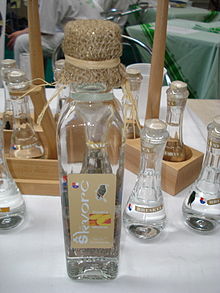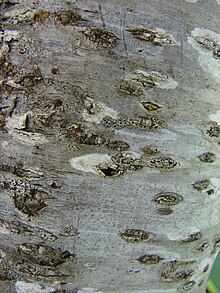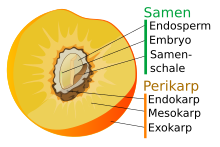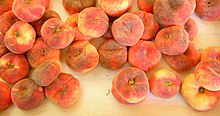peach
| peach | ||||||||||||
|---|---|---|---|---|---|---|---|---|---|---|---|---|

Peach ( Prunus persica ), illustration |
||||||||||||
| Systematics | ||||||||||||
|
||||||||||||
| Scientific name | ||||||||||||
| Prunus persica | ||||||||||||
| ( L. ) Batsch |
Of peach ( Prunus persica ) is a species of the genus Prunus within the family of Rosaceae (Rosaceae). Its fruits are called peaches and belong to the stone fruit .
description
Vegetative characteristics
The peach is a tree that reaches heights of 1 m to 8 m. Its branches are straight and bare. Young twigs are red on the sunny side and green on the side facing away from the sun. The long shoots have an end bud . Side buds are usually present in three leaf axils , at least with strong long shoots . The buds are hairy.
The alternate arranged leaves are divided into petiole and leaf blade. The petiole has a length of 1 cm to 1.5 cm. With a length of 8 cm to 15 cm and a width of 2 cm to 4 cm, the simple leaf blade is lanceolate with a broad wedge-shaped blade base and a pointed to long pointed upper end. The leaf margin is usually double and more or less finely serrated. The widest part of the leaf blade is in the middle or slightly above. The top and bottom of the leaves are dark green and bare. The leaves are folded in the bud position .
Generative characteristics
The flowering time is in Central Europe in April. The mostly single flowers are very short stalked or almost sessile. They are surrounded by bud scales at the base and unfold before the leaves. The hermaphroditic flowers have a diameter of 2.5 cm to 3.5 cm and are radially symmetrical and five-fold with a double flower envelope . The flower cup is bell-shaped, length and width are approximately the same. The five sepals have entire margins and are woolly hairy on the outside. The five mostly deep, rarely pale pink petals are up to 2 cm long, oval and usually with entire margins. The approximately 20 mostly reddish, rarely yellow stamens are slightly shorter than the petals.
The mostly spherical stone fruit has a diameter of 4 cm to 10 cm and a longitudinal furrow. The skin of the fruit is pale green or yellow, reddish on the sunny side and often covered with velvety hair, but still smooth. The “ pulp ” is juicy, thick and pale green or orange.
The mostly almost spherical stone core has a thick shell, deep furrows and is very hard.
Chromosome number
The number of chromosomes is 2n = 16.
sorts
Criterion: pulp color / type of core solution
There are white, yellow and red-fleshed varieties and among them are those that dissolve stones ("Freestones", "Core donors") and non-stone-releasing ("Clingstones", "Durantien").
sorts
There are numerous types of peach (selection):
- 'Benedicte' (white flesh, stone loosening)
- 'Dined'
- 'Formerly Alexander'
- 'Formerly Roter Ingelheimer'
- 'Red Haven' (yellow-fleshed, stone-soluble)
- 'Revita'
- ' Roter Ellerstädter ' (= 'Kernechter vom Vorgebirge' / 'Vorgebirgspfirsich')
- 'Record from Alfter' (= 'Record from Alfter')
- 'Suncrest'
- 'South Haven'
- ' Red vineyard peach ' (pulp varies from white to red, not always completely stone-releasing) - The 'vineyard peach' has a dark red, very firm “pulp” and a dark, furry skin. The “pulp” is usually less sweet than that of other varieties, but has a more intense peach taste and smell. Therefore, it is rarely eaten raw, but mainly processed into jam or liqueur or cooked in glasses.
- 'White Ellerstadt'
Varieties
Flat peach
A variety is the Platt peach ( Prunus persica var. Platycarpa (Decne) LH Bailey. , Syn .: Prunus persica (L.) Batsch forma compressa (Loudon) Rehder , in Spain) paraguayo (plural: paraguayos ) or paraguaya is called . Flat peaches have been offered in the fruit trade (mostly at higher prices than "round peaches") under the name "Wild peaches", "Adelsberg peaches", "Mountain peaches", "Saturn peaches" or "Vineyard peaches" in recent years.
The name "Weingartenpfeach", which is also used but is improperly, is not permitted in Austria because it is a registered name.
nectarine
The nectarine ( Prunus persica var. Nucipersica (Suckow) CK Schneid. ) Is also a variety or mutation of the peach with a smooth skin and on average smaller fruits. There are also numerous varieties of this.
A newer hybrid is the Nectavigne . This is the result of a cross between nectarine and the 'Lyonaiser Weinbergpfeach'.
Cultivation
Peaches are vernalized and therefore need several hundred hours of winter cold to thrive. On the other hand, the early flowering (in Western Europe as early as March) can be affected by late frosts. Winter rain favors fungal infestation by Taphrina deformans ( curl disease ), which is why peaches are rarely grown in Europe without the use of fungicides. In Central Europe , the flowering time is in April, and the peach is mainly grown in wine-growing areas . The peach is multiplied mainly by budding .
In most regions in Central Europe, juicy, aromatic peaches can in principle only be harvested in your own garden. Exceptions are wine-growing areas such as Rheinhessen, which also have commercial peach plantations. The purchased peaches are usually taken from the tree while they are still hard so that they can survive the transport. However, such fruits do not ripen completely and the typical peach aroma is not as pronounced.
Peaches need to be pruned regularly, otherwise they will become bald from the inside.
Economical meaning
The largest peach producers
Around 24.5 million tons of peaches (including nectarines) were harvested worldwide in 2018. The following table gives an overview of the 10 largest producers of peaches (including nectarines) worldwide, who produced a total of 86.4% of the harvest.
| rank | country | Quantity (in t ) |
|---|---|---|
| 1 |
|
15.195.291 |
| 2 |
|
1,090,678 |
| 3 |
|
903,809 |
| 4th |
|
938,000 |
| 5 |
|
789.457 |
| 6th |
|
700,350 |
| 7th |
|
645,499 |
| 8th |
|
319,047 |
| 9 |
|
278.417 |
| 10 |
|
246,742 |
| world | 24,453,425 |
Growing areas
The main growing areas for peaches in Europe are Italy, Greece and Spain.

The cultivation area for peaches worldwide increased from 1.27 million hectares in 2000 to 1.7 million hectares in 2018.
use
Large proportions of peach fruits are marketed fresh as fruit . Peaches in halves or carving are a common form of canned fruit . The kernels are removed from the shell, processed into Persipan and used in the flavoring of spirits .
There are also some descriptions of the medicinal uses of the peach. For example, Hildegard von Bingen recommended the unripe fruit including the kernels, the leaves, the roots, the resin and the bark for external use for watery eyes, headaches and gout . The semen can be poisonous in large quantities because it contains about 6.5% prussic acid- releasing amygdalin . The leaves contain a related hydrocyanic acid glycoside.
The rubber-like excretion of the fruit was used as an adhesive in some areas until synthetic glue was produced.
history
According to genetic research, at least 6000 BC Began with the expansion of the peach through breeding selection in southern China , where its culture since 2000 BC. Chr. Is handed down. It then came to Greece via Persia and subsequently to Central Europe through the Romans.
Word origin
The word "peach" (first used in Nuremberg in 1482) for the tree, which probably came from China and came to Europe via Persia, and its fruit comes from the Middle High German pfërsich (from phërsich ) from vulgar Latin persica or persicus . The “Persian apple” ( Latin malum persicum , to Persicus “Persian”) originated from synonymous ancient Greek μῆλον περσικόν mēlon persikón from περσικός persikós (“Persian”), this from Περσίς Persís (“Persia”).
symbolism
In Christological symbolism, the peach stands for the Trinity (due to its three-part division into meat, stone and seeds).
In China , the peach is a symbol of immortality. In Taoist mythology, the Queen Mother of the West ( Xiwangmu ) grows the fruits in a remote mountain valley, where they only ripen every thousand years. A famous work by the poet Tao Yuanming is entitled The Peach Blossom Spring and tells of an ideal society far away from civilization. In addition, various sexual connotations are associated with the image of the peach.
ingredients
| Calorific value | water | fat | potassium | Calcium | magnesium | vitamin C |
|---|---|---|---|---|---|---|
| 172 kJ (41 kcal) | 87 g | 0.1 g | 205 mg | 8 mg | 9 mg | 10 mg |
| potassium | Calcium | magnesium | vitamin C |
|---|---|---|---|
| 9% | 1 % | 3% | 13% |
Diseases
- Viruses : Scharka ( Plum Pox Virus ), ring spots ( Prunus Ringspot Virus ), dwarfism ( Prunus Dwarf Virus ), Strawberry Latent Ringspot Virus
- Bacteriosis : root goiter ( Agrobacterium tumefaciens ), bacterial blight ( Pseudomonas mors-prunorum )
- Mycoses : curl disease ( Taphrina deformans ), peach powdery mildew ( Sphaerotheca pannosa var.persicae )
literature
- Manfred Fischer (Ed.): Color Atlas of Fruit Types . 2nd Edition. *, Stuttgart 2003, ISBN 3-8001-5547-8 .
Individual evidence
- ↑ peach. In: FloraWeb.de.
- ↑ a b c d e f Hildemar Scholz, Ilse Scholz: Prunoideae. , Pp. 446-510. In: Hildemar Scholz (Hrsg.): Illustrated flora of Central Europe. Founded by Gustav Hegi. 2nd, completely revised and enlarged edition. Volume IV Part 2B: Spermatophyta: Angiospermae: Dicotyledones 2 (3) (Rosaceae, 2nd part) , Blackwell, Berlin / Vienna et al. 1995, ISBN 3-8263-2533-8 .
- ↑ a b c peach and nectarine. In: https://www.lwg.bayern.de/index.php . Retrieved September 15, 2018 .
- ↑ Bastian et al .: My home: Chemnitz and the surrounding area . Schreiter, Arnsfeld, 2009.
- ↑ Traditional cultivation of vineyard peaches in Austria ( Memento of the original from November 17, 2015 in the Internet Archive ) Info: The archive link was inserted automatically and has not yet been checked. Please check the original and archive link according to the instructions and then remove this notice. (Information from the Austrian Federal Ministry for Agriculture, Forestry, Environment and Water Management).
- ↑ Rudolf Metzner: Cutting the fruit trees and berry bushes . Eugen Ulmer Verlag, Stuttgart, 12th edition 1966.
- ↑ a b c Crops> Peaches and nectarines. In: FAO production statistics for 2018. fao.org, accessed on April 6, 2020 .
- ↑ Harald Nielsen: Poison Plants . Franckh'sche Verlagshandlung (Kosmos Feldführer) 1979, ISBN 3-440-04715-6 .
- ^ Y. Zheng, GW Crawford, X. Chen: Archaeological Evidence for Peach (Prunus persica) Cultivation and Domestication in China. , 2014, PLoS ONE 9 (9): e106595. doi: 10.1371 / journal.pone.0106595
- ^ Friedrich Kluge , Alfred Götze : Etymological dictionary of the German language . 20th edition, ed. by Walther Mitzka , De Gruyter, Berlin / New York 1967; Reprint (“21st unchanged edition”) ibid 1975, ISBN 3-11-005709-3 , p. 544.
- ↑ Christina Becela-Deller: Ruta graveolens L. A medicinal plant in terms of art and cultural history. (Mathematical and natural scientific dissertation Würzburg 1994) Königshausen & Neumann, Würzburg 1998 (= Würzburg medical-historical research. Volume 65). ISBN 3-8260-1667-X , p. 205.
- ↑ a b EU nutrition labeling directive ( directive 90/496 / EEC )
- ↑ Rewe nutritional table peaches and nectarine. In: foodnews.ch. Retrieved November 9, 2012 .
- ↑ PDF. ( Page no longer available , search in web archives ) Info: The link was automatically marked as defective. Please check the link according to the instructions and then remove this notice.
Web links
- Peach. In: FloraWeb.de.
- Profile and distribution map for Bavaria . In: Botanical Information Hub of Bavaria .
- Prunus persica (L.) Batsch In: Info Flora , the national data and information center for Swiss flora . Retrieved November 10, 2015.
- Thomas Meyer: Data sheet with identification key and photos at Flora-de: Flora von Deutschland (old name of the website: Flowers in Swabia )












